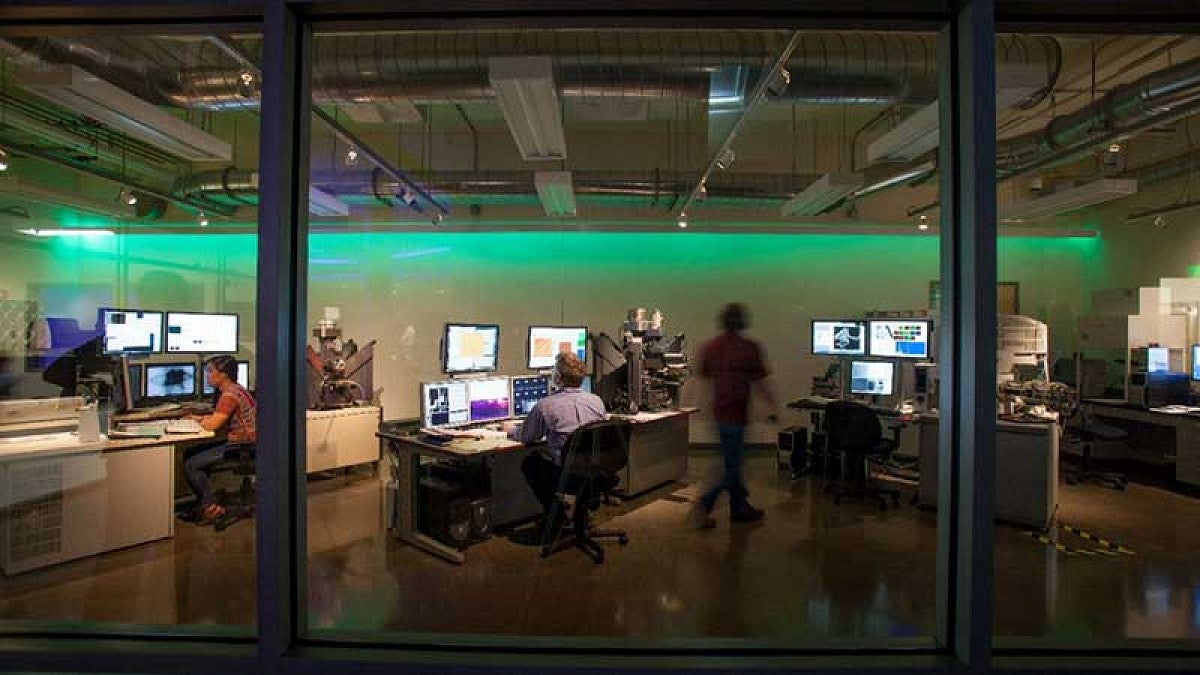While many University of Oregon labs have been forced to scale back activities due to the coronavirus pandemic, one research center has remained busier than ever throughout the health crisis.
Since March, the Center for Advanced Materials Characterization in Oregon, also known as CAMCOR, has been working with numerous outside industry partners on critical COVID-19 projects. This includes everything from testing COVID-19 screening kits and potential therapeutic treatments for the disease to improving air sterilization products and building better face masks.
“We’ve done a fair amount of COVID work and it gives me a lot of pleasure knowing that we’re making a difference,” said Kurt Langworthy, director of CAMCOR. “We’ve always worked with industry to help them solve problems, but to see it tied so closely to helping during this pandemic has given us a strong sense of purpose.”
A full-service center that’s home to highly specialized labs and equipment, CAMCOR caters to faculty researchers, outside industry partners and researchers from other academic institutions. Additionally, many of its multimillion-dollar tools can be operated remotely, which has proven to be advantageous during the pandemic. Even before the crisis began, roughly half the center’s clients worked remotely with CAMCOR staff.
“We have to go to the lab to put samples in the instruments, but as far as the customer is concerned, it can all be done virtually,” Langworthy said. “Samples can all be shipped by Fed Ex and we can load them up, get them into tools, acquire and then discuss data. We are in a position where we can provide very valuable services without interacting directly with the public. There are a lot of clients that we don’t see in person”
When the UO shifted to remote operations in early March, critical research activities including supporting COVID-19-related research and development was one exception. This included much of the work conducted at CAMCOR and, Langworthy said, the center prioritized its collaborations with clients working on essential projects.
Synexis, a Kansas-based company that is pioneering microbial reduction technologies for occupied spaces, worked with CAMCOR researchers to examine the chemical composition of materials in its Dry Hydrogen Peroxidetechnology. The product is a patented, FDA-regulated technology proven to mitigate viruses, bacteria and mold inside occupied spaces.
Dry Hydrogen Peroxide continuously decontaminates the air and surfaces throughout the facility, including hard to reach or remote areas not typically addressed in intermittent cleaning. The technology is being employed as a means of eliminating microbes from restaurants, casinos, offices, hospitals, student housing and other indoor spaces.
Synexis recently signed an agreement to supply a major fast food chain with its products, and the company has seen its sales increase in 2020.
“We were excited to work with CAMCOR researchers to conduct our study because of their cutting-edge capabilities, especially related to COVID-19,” said Eric Schlote, CEO of Synexis. “We were able to validate the effectiveness of our Dry Hydrogen Peroxide technology and ensure our customers that our system attacks viruses, bacteria and mold that is present in the air or on a surface, even if the occupants don’t know it’s there.”
Other critical CAMCOR projects included helping an East Coast company to fast-track Food and Drug Administration approval of its “better than N-95 masks.” By imaging new materials for the face mask, CAMCOR staff members were able to help the company prove the technology worked as promised, enabling it to develop a reusable, washable face mask and rush it to market.
In addition to personal protective equipment, the CAMCOR team has worked on COVID-19 treatments, cleaning products and testing kits and provided “second-order” contributions by helping tech firms improve their data analysis capacities and computing technologies that can be applied to combatting the virus. CAMCOR has 10 staff members spread out into specialized labs. Six of those staff members have been focused on COVID-19 projects.
Some of CAMCOR’s critical projects being carried out during the pandemic are not specifically related to COVID-19. Golledge and other staff have worked with clients to solve corrosion issues on surgical instruments and collaborated with pharmaceutical companies on drugs that are considered essential but not related to COVID-19.
Founded in 2004, CAMCOR was dug right into the bedrock in an underground site in the heart of UO’s complex of science buildings. Part of the Lorry I. Lokey Laboratories, it was created to help train graduate students and provide high-tech tools and equipment to UO faculty members and other researchers.
Collaborations with industry partners help cover the center’s operating expenses, and over the years CAMCOR has partnered with everyone from Dune Sciences to Intel. As one of the UO’s Research Core Facilities, the center helps advance research and is overseen by the Office of the Vice President for Research and Innovation.
“The services and expertise being provided by CAMCOR during this time of unprecedented need are a real testament to the value of research universities such as the University of Oregon,” said Cassandra Moseley, UO’s incoming interim vice president for research and innovation. “We have been focused on how we support the response effort while we continue our academic and research priorities. CAMCOR’s continued operation during the pandemic has been an important part of that effort.”
—By Lewis Taylor, University Communications


